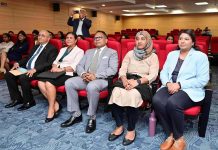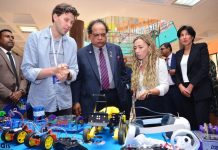By The Editorial Board
Africa-Press – Mauritius. In the wake of the campaign for achievement of the Education for All goals across Africa, there is an emerging consensus within the international education community on a number of conclusions arising out of both experience and analysis:
1.The importance of Human Resource Development to sustain economic growth and social development, is more obvious than ever before in the context of a knowledge based globalised economy.
Rapid technological advances make for ever increasing complexity in the forms and levels of knowledge and skills with the implication that developing economies require on the one hand, a sizeable number of middle skilled workers and on the other hand a critical mass of secondary and higher education graduates.
Indeed, the experience of the newly industrialized countries testifies to the link between a relatively high Lower Secondary Education completion rate and sustainable economic growth. Hence, the increasing importance being ascribed to ‘‘Lower’’ or “Junior’’ Secondary Education, now considered as part of basic education.
Both NEPAD’s Education Strategy Framework and the Ministerial Statement of the 2005 Algiers conference of African Union Education Ministers thus underline the necessity of expanding and diversifiying secondary education.
2.In actual fact, over the last years, the very noticeable progress in moving towards the EFA goals in Africa has led to a higher completion rate at primary level and predictably, growing demand for secondary education.
Such a trend is expected to persist and will have far reaching implications the more so as secondary enrolment for Sub Saharan Africa has historically been very low, with at present a gross enrolment rate approximating 28% according to UNESCO’s EFA Global Monitoring Report of 2006.
What has actually been witnessed on the ground is a dramatic increase in student numbers within Lower Secondary Education coupled with a shift in the student profile at that level reflecting lower literacy and numeracy skills and preparedness generally.
3.It follows almost naturally that there has been a drop in the retention rate within Lower Secondary Education as well as a fall in the transition rate from Lower Secondary Education to Upper Secondary Education.
Had this not been the case, conventional wisdom would dictate some form of regulation of student flows at least for a while given the explosion in attendant costs for the state, linked to the exponential increase in secondary enrolments and the labour market constraints.
In both scenarios, an increase in the number of school leavers or dropouts aged between 12 and 16 becomes a near certainty raising the issue of how the schooling process equips them for life and hence curricular reforms.
4.As the size and profile of the student body at Lower Secondary Education level undergo profound changes, a redefinition of Lower Secondary Curriculum assumes paramount importance. The traditional curriculum was designed within an elitist perspective of preparation of a successful few for further studies.
The quite sudden and dramatic expansion of secondary education to accommodate ever larger numbers, most of whom will not go on to further studies ushers in the necessity of a broad and relevant curriculum on the basis of a renewal of learning contents to incorporate generic skills and key competencies fostering employability and citizenship.
The whole perspective of curriculum design and implementation thereby shifts to preparation for the world of work and acquisition of life skills for individual and social development.
The recent experience of Namibia and South Africa is most instructive in that regard while in francophone Africa, “l’approche par les compétences” is gaining ground with Gabon as an interesting example.
In parallel to the expansion of the Lower Secondary school population, globalization and the requirements of the knowledge economy are powerful factors dictating the shift in focus from factual knowledge to competencies.
developing economies require on the one hand, a sizeable number of middle skilled workers and on the other hand a critical mass of secondary and higher education graduates.
5.A parallel development relates to the diversification of secondary education with the possibility of providing different pathways at Lower Secondary Level for the more academically oriented students on the one hand, and for those deemed more inclined towards vocational or pre-vocational studies on the other.
The preferred option so far is the maintenance of a general secondary stream but with increased vocationalisation of the curriculum, often associated with the competency-based approach.
Whatever the national preference, an inescapable conclusion is that the nature of secondary education is changing, reflecting the search for ways to reconcile the expansion of secondary education with the requirements of labour markets.
Hence,the growing emphasis on life skills and generic competencies to define a new core curriculum. 6. In turn, the profound curricular reforms anticipated require the re-visiting of traditional pedagogy founded on the assumption of finite knowledge and a one-way teaching and learning process.
On the one hand,teaching methods and strategies are called upon to change so that the teacher becomes more of a facilitator and his students,autonomous learners.
On the other hand, teaching itself shifts from the traditional “teaching-to-the-test” to the task of ensuring that every student has acquired the basic skills or competencies at the heart of the new curriculum.
To summarize, in line with the historical experience of economic development being associated with the vast extension of educational opportunities, Africa is experiencing a rapid extension of lower secondary education and as a natural corrollory, higher numbers of secondary school drop-outs.
This unfolding process is leading to a renewal of the Lower Secondary Curriculum, and in turn, to a refoundation of traditional pedagogical approaches. Such a contextual change obviously has profound implications for assessment and certification.
Assessment and Certification The role ascribed to assessment,within the perspective of Lower Secondary expansion, should be to measure the effectiveness of schooling and in particular,of the teaching and learning process, but in respect of the redefined curriculum and expected learning outcomes.
The adoption of a competencies-based approach implies that assessment and certification be considered from a global view point with three broad objectives: (1) monitoring of systemic performance [including implementation of curricular reforms and teaching effectiveness] (2) recognition of positive achievement on the basis of pre-defined standards [as opposed to the traditional Pass or Fail approach] (3) promotion of employability and lifelong learning through recognition and certification of achievement throughout schooling.
The first issue that obviously arises in order to ensure coherence between curriculum design and assessment is to define the skills and competencies to be assessed.
A useful starting point is the OECD’s Framework for Key Competencies which rests on three broad conceptual categories [Interacting in socially heterogenous groups, Acting autonomously, Using tools efficiently]in order to identify and map out key competencies.
At a recent seminar jointly organized in May 2005 by the International Institute for Educational Planning[IIEP] and the Association for the Development of Education in Africa [ADEA],experts agreed that the generic skills and competencies should include the following: – Literacy and Numeracy – IT Literacy – Team work skills – Problem-solving skills – Critical thinking – Flexibility and adaptability – Learnability – Autonomy The shift from content-based to competencies-based assessment presents yet another difficulty.
The validation and recognition of learning implies the obvious need to define levels of competencies and achievement. Any competency,need we recall,is on a continuum through different levels.
The establishment of benchmarks for each stage of schooling and the definition of levels grouping sets of competencies may require expertise other than that locally available in Afican countries.
The choice as between alternative modes of assessment of competencies [observation, portfolio, project work, self-assessment] is context bound but crucial to build support within the educational community and achieve credibility.
Reconciling traditional examinations at the end of Lower Secondary with competencies-based assessment may yet be another headache for policymakers as unfamiliarity of parents with the latter may lead to confusion or conflicting expectations.
Implementation of such changes as are described above in order to evolve a new African model of lower secondary education resting on a competencies-based curriculum is bound to constitute a protracted and complex process fraught with difficulties.
African policy makers can only rise to the challenge by studying relevant international experience and focusing on best practices. A pilot project in Mauritius A pilot project under preparation in Mauritius may serve to illustrate the challenges and promises of assessment and certification in the context of the expansion of secondary schooling in an African context.
In Mauritius, the persistent high rate of failure at end-of – primary examinations (25% of a typical cohort) coupled with the significant number of school drop-outs at Lower Secondary convinced the Ministry of Education that to address the manifest dysfunctionality of the educational system, a new approach needs to be adopted.
Hence the proposed focus on competencies and essential life skills, alongside rather than as an alternative to the traditional academic assessment, with the avowed aim of enhancing the relevance of the schooling process.
Furthermore the extension of compulsory education up to age 16, that is the introduction of eleven years of schooling for all young persons, strongly indicated the need for certification of positive achievement in terms of knowledge, skills and competencies acquired during, and retained at the end of, the schooling process.
A pilot project was therefore initiated to evolve a competencies-based compulsory assessment before the age of 16 yielding a ‘Record of Achievement’ issued to all students and most importantly to prospective school drop-outs who more often than not didn’t posses any academic certificate other than the Certificate of Primary Education.
As designed, the record of achievement was to meet three objectives: Promotion of employability and flexibility within the world of work as an instrument more meaningful to prospective employers than the pre-existing ‘Certificate of Primary Education’.
Facilitation, for the present school-leaver, of a return to Education or enrolment for vocational training at any later stage in life. The record of achievement equivalent to a secondary school-leaving certificate should the student drop out thereby acts as a ‘passport for lifelong education’.
It assists any institution of further learning/training to define the entry point of the applicant on a course. Encouragement by virtue of the above to the development of a comprehensive and functional National Qualifications Framework, favouring the portability of qualifications, bridging Education and Work, promoting lifelong learning.
“The choice as between alternative modes of assessment of competencies [observation, portfolio, project work, self-assessment] is context bound but crucial to build support within the educational community and achieve credibility.
” The project is innovative in more ways that one.
As explained, it provides for certification of skills and competencies in term of levels of achievement and performance standards instead of grades and marks.
Most importantly, it marks a complete break in the traditional examination approach of ‘passing’ or ‘failing’ students and aims instead to provide all young persons before they leave school with a ‘statement of attainment’ testifying to positive achievement and serving as a passport both to the world of work and for lifelong learning.
Thus, no student is labelled a failure but each and every one is provided with an attestation of his level of mastery in regard to what are considered essential skills/competencies required by society. In other words, the functional dimension of learning outcomes becomes the primary focus of assessment.
To that end, a National Assessment Framework spanning both primary and secondary education across the eleven years of compulsory schooling has been developed as a basis for standards to be prescribed, targets to be set and pupils’ achievements and progress charted.
The expected progression for all pupils throughout the school system and the benchmark levels are presented in Tables I and 2 which are reproduced together with some explanatory remarks from a Working Document of the Ministry of Education of Mauritius and the Mauritius Examination Syndicate. By mid-2005, a “School Leaving Assessment Scheme at Age 16” had been developed to certify skills and competencies acquired by each pupil.
Seven levels of achievement, formulated in terms of skills and competencies, had been defined in the following areas: Communication skills and Literacy in English Communication skills and Literacy in French Numeracy and Mathematics Information and Communication Technology skills For each level, a set of descriptors were formulated as bench marks or indicators of performance representing expected standards.
It was envisaged that the assessment should be made compulsory and carried out in the course of the 4th year of Secondary so as to reach all students before they attain the legal school leaving age.
Special arrangements were to be made for 15-year olds in lower classes to be assessed. Further, so as not to interfere with traditional end-of-year examinations, the assessment was to be organized towards the middle of the academic year.
In the context of an examination-focused educational system within a society geared to academic achievement as described by marks, grades and rank, to put forward an alternative vision of assessment through the recognition and certification of positive achievement as expounded above, requires a fundamental mind shift.
Hence, the early emphasis placed on consultations with practicing teachers, school inspectors as well as employers. In Mauritius, as elsewhere, the successful implementation of such a project will require strong political commitment sustained over time together with the ability to forge a favourable consensus amongst Heads of schools, teachers, parents and not least, students.
In practice, it will require the training of teachers in appropriate assessment techniques and designing of coursework assessment which is not without difficulties of its own. But, in education, the status quo is not an alternative.
For the key question remains: Given the rapid rise in secondary student numbers, is it justified and fair that students should be allowed to leave school after having invested many years of their lives in formal education without any recognition of their achievements?
https://lexpress.mu/article/implications-assessment-and-certification-africa-and-mauritius
For More News And Analysis About Mauritius Follow Africa-Press







